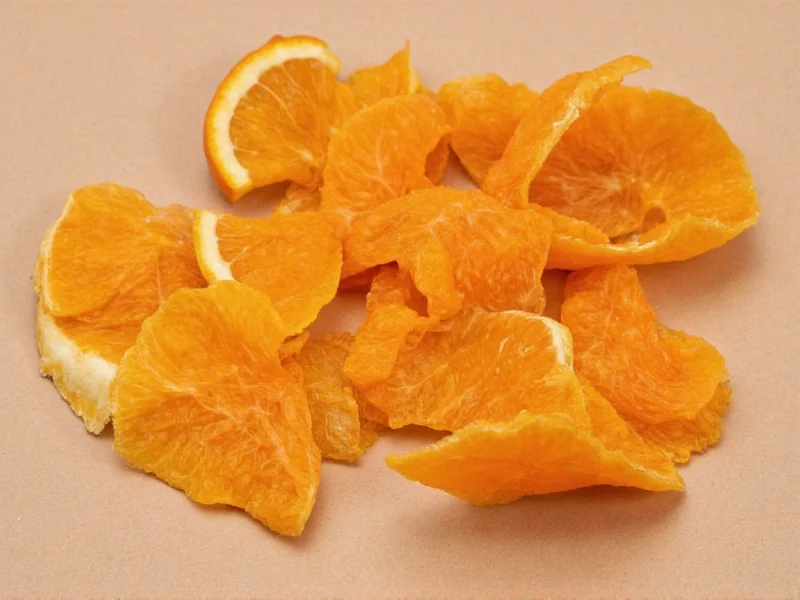Understanding Dried Orange Peel Properties
Orange peel transforms significantly when dried. The dehydration process concentrates limonene (up to 97% of peel oil), hesperidin, and other bioactive compounds. Unlike fresh rind which spoils within days, properly dried orange peel maintains potency for 6-12 months. Historical records show Mediterranean cultures preserving citrus peel since the 12th century for both culinary and medicinal purposes. Modern research confirms dried citrus rind contains higher concentrations of polyphenols per gram than fresh peel due to water removal.
Effective Drying Methods Compared
| Method | Time Required | Temperature | Flavor Retention | Best For |
|---|---|---|---|---|
| Air Drying | 3-7 days | Room temperature | Moderate | Organic peels, small batches |
| Oven Drying | 2-4 hours | 170°F (77°C) | High | Quick processing, larger quantities |
| Food Dehydrator | 8-12 hours | 95-115°F (35-46°C) | Excellent | Optimal nutrient preservation |
| Sun Drying | 2-5 days | Variable | Low-Moderate | Dry climates only |
Step-by-Step Drying Process
For optimal results when learning how to dry orange peel at home, follow these science-backed steps. First, thoroughly wash organic oranges with baking soda solution to remove waxes and pesticides. Non-organic peels require special attention to chemical residues. Using a vegetable peeler, remove zest in thin strips avoiding the bitter white pith. Cut into uniform 1/4-inch strips for even drying.
The oven method delivers reliable results for most households. Arrange peel strips in a single layer on parchment-lined baking sheets. Set oven to its lowest temperature (ideally 170°F/77°C) with door slightly ajar. Rotate trays hourly for 2-4 hours until peel snaps when bent. Check every 30 minutes during final drying stages to prevent burning. This technique maximizes the retention of volatile oils that provide dried orange peel's distinctive aroma.
Storage Best Practices
Proper storage determines dried orange peel shelf life. After cooling completely, store in airtight glass containers away from light and moisture. Include silica gel packets to absorb residual humidity. For extended storage beyond six months, vacuum sealing with oxygen absorbers maintains freshness for up to two years. Never store in plastic bags which trap moisture and encourage mold growth. Check monthly for any signs of moisture or discoloration.
Culinary Applications Beyond Zest
Dried orange peel offers unique culinary advantages over fresh zest. When ground into powder, it provides consistent citrus flavor in baked goods without adding moisture. Use 1 teaspoon dried peel powder to replace one tablespoon fresh zest. Simmer whole dried strips in poaching liquids for pears or apples to infuse subtle citrus notes. Add to spice rubs for meats where fresh citrus would create texture issues. The concentrated oils in dried peel release more slowly during cooking, creating longer-lasting flavor profiles.
Scientifically Supported Health Benefits
Research published in the Journal of Agricultural and Food Chemistry confirms dried citrus peel contains higher concentrations of flavonoids than fresh peel. Hesperidin levels increase by approximately 30% after proper dehydration. These compounds demonstrate anti-inflammatory properties and may support cardiovascular health. Dried orange peel tea preparation maximizes bioactive compound extraction - steep 1 teaspoon crushed peel in 8 ounces of boiling water for 5-7 minutes. Note that medicinal benefits require proper dosage; consult healthcare providers before using dried peel therapeutically.
Household and Sustainable Uses
Using dried orange peel for natural cleaning leverages its d-limonene content, a powerful degreaser. Create an all-purpose cleaner by steeping dried peel in white vinegar for two weeks, then strain. This solution effectively cuts through kitchen grease without harsh chemicals. Place dried strips in closets or drawers as natural moth repellents. Bury small pieces in garden soil to deter ants while providing slow-release nutrients. These applications transform food waste into valuable resources, aligning with zero-waste kitchen principles.
Avoiding Common Preservation Mistakes
Many home preservers make critical errors when drying citrus peel. Setting oven temperatures too high (above 200°F/93°C) destroys delicate essential oils. Inadequate air circulation during air drying causes mold growth on the underside of peel strips. Storing before complete dryness leads to spoilage within weeks. Non-organic peels often retain pesticide residues that concentrate during drying. Always test dryness by bending a piece - it should snap cleanly without flexibility. Properly dried peel feels leathery initially but becomes brittle when fully dehydrated.
FAQ
Can I use dried orange peel from store-bought non-organic oranges?
While possible, non-organic orange peel often contains wax coatings and pesticide residues that concentrate during drying. If using conventional oranges, scrub thoroughly with baking soda paste and remove thicker outer layer. Organic peels remain preferable for consumption purposes due to lower chemical exposure risks.
How long does properly dried orange peel last?
When stored in airtight containers away from light and moisture, dried orange peel maintains optimal quality for 6-12 months. Vacuum-sealed with oxygen absorbers, shelf life extends to 18-24 months. Discard if you notice any mold, off odors, or significant color fading beyond golden brown.
What's the best way to grind dried orange peel?
For fine powder, use a dedicated coffee grinder after ensuring complete dryness. Pulse in short bursts to prevent overheating, which degrades essential oils. For coarser texture, a microplane zester works well on partially softened peel. Always grind in small batches and store powder in dark glass containers to preserve potency.
Does drying affect the vitamin C content in orange peel?
Vitamin C degrades significantly during drying, with losses of 60-80% depending on method. However, dried peel retains other valuable compounds like flavonoids and limonene at higher concentrations per weight than fresh peel. For vitamin C benefits, consume fresh citrus; for other bioactive compounds, dried peel offers advantages.











 浙公网安备
33010002000092号
浙公网安备
33010002000092号 浙B2-20120091-4
浙B2-20120091-4